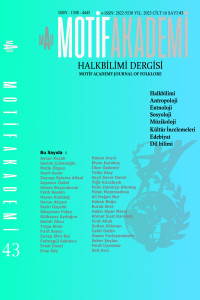ORTA ÇAĞ AVRUPASI’NDA DİN DIŞI MÜZİK VE GEZGİN MÜZİSYENLİK GELENEKLERİ
NON-RELIGIOUS MUSIC AND TRAVELING MUSICIAN TRADITIONS IN MEDIEVAL EUROPE
Author(s): Ali Doğan NUR, Hakan BağciSubject(s): Cultural history, Music, Social history, 6th to 12th Centuries, 13th to 14th Centuries, 15th Century, Sociology of Art, History of Art
Published by: Motif Halk Oyunları Eğitim ve Öğretim Vakfı
Keywords: Travelling Musicians; Traveling Musician Traditions; Medieval European Music; Non-religious Music;
Summary/Abstract: Although it is known that there are songs and dances belonging to different nations in the history of music, there are also songs and dances whose origins are unknown. Many of them are said to have originated in ancient times,some deriving from church music; others were created by travelling musicians in the Middle Ages. In addition to Gregorian chant, the melodic repertoire created by itinerant musicians, which evolved more naturally into a major-minor tonality, formed the basis of both religious and secular music in the following centuries. Travelling musicians, who were both poets and musicians, travelled from province to province, staying in towns and castles and spreading news and events through their songs. These talented and experienced poets-musicians based their fame on their poems and songs, especially those dealing with "pure and noble" love. Travelling musicians, who spread across Europe for centuries, were known by different names at different times, in different countries and regions. These travelling musicians were called "troubadour" in Southern France and Provence, "trouvère" in Northern France, "minnesänger" and later "meistersinger" in Germany and Austria, "minstrel" and "gleeman" in England, "travatore" in Italy and "trovador/trobador" in Spain. Apart from these, "jongleur", "ménestrel" and "goliard" are also important representatives of this tradition. The common theme of the travelling musicians in their works is the mysterious love that they cannot reach. It is known that some travelling musicians, who sang, recited poetry and even danced while playing instruments, added a different dimension to music with the cymbals they wore on their bodies, and even performed one-man shows by juggling and clowning to music. In medieval Europe, non-religious songs and dances accompanied many aspects of everyday life, not only entertaining crowds in marketplaces but also adding colour to special events such as royal visits and religious festivals.
Journal: Motif Akademi Halkbilimi Dergisi
- Issue Year: 16/2023
- Issue No: 43
- Page Range: 1263-1284
- Page Count: 22
- Language: Turkish

